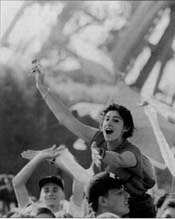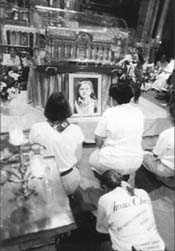by Domenico Bettinelli, Jr.
This article first appeared in the October 1997 issue of Catholic World Report. This is the original version and not the final published and edited version, but all copyrights still apply. Copyright 1997 Catholic World Report.
Less than two weeks before the events of the 12th World Youth Day were to begin in Paris, French Catholic organizers feared that European youths and young adults would not show up to meet with Pope John Paul and their peers from around the world in the numbers for which they had hoped. But when the pilgrims gathered in Paris for the extraordinary event from August 19-24, they exceeded the most hopeful estimates by more than half.
The festival of Catholic youth and young adults, known as World Youth Day, occurs almost every two years and began early in the pontificate of the Holy Father who has a special regard for youth ministry throughout his priesthood. The Pope has often spoken of the reason for the events as being an encouragement for these Catholics who are the future of the world. "These young people -- the hope and future of the world -- are being called upon to lead in times when the foundations of a much more sharing and closely knit society are being laid," the Holy Father said the week before World Youth Day as he prepared for the event at his summer residence outside Rome.

Jubilant youth greet Pope John Paul at opening ceremonies
Those gloomy estimates were cast aside though when 350,000 youngsters from 140 countries braved the hottest summer in Paris since records began to be kept in the 18th century and gathered for opening ceremonies on August 19 at the foot of the Eiffel Tower with Jean Marie Cardinal Lustiger of Paris and again on August 21 to greet the Pope at his first appearance of the event. And later, during the papal Mass at Longchamps Hippodrome race track, more than 1.3 million gathered for the celebration.
Although he appeared initially frail, with the oppressive heat and humidity no doubt hindering him, the Pontiff appeared to draw energy from wildly cheering crowd at the Eiffel Tower. In his first words to the youths, most of whom were between 18 and 35 years old, he exhorted them toward unity with another and called on them to reject materialism in favor of "the radical novelty of the Christian life." He added that they should live "in the light of the lives of the saints and the other witnesses to the Gospel," and thereby become "apostles of the year 2000."
While France is traditionally named "eldest daughter of the Church," the majority Catholic population often rejects the Church's moral teachings in its governmental policies and free-wheeling lifestyle. The contrast was highlighted during the week by the proclamations by Socialist government ministers that the Holy Father's visit was "a great moment for the country" and the newspaper Le Monde's declaration of the "triumph of John Paul" on the one hand, and the controversy surrounding a demonstration by pro-life activists and the Pope's visit to the grave of his friend, Jerome LeJeune, a prominent geneticist who was a leading pro-life scientist. "The demonstration was quite unwelcome," said the French security chief for the papal visit, "and I hope that it will not spoil the impression of joy, hope, and solidarity during these days."
Many Parisians seemed bemused by the influx of hundreds of thousands of jubilant youths into their city during what is traditionally a time when the French escape the city heat for country vacations. One American tourist remarked, "I've never seen the city so full of joy. The Metro was literally filled with their singing." Parisian police officials agreed that the weeklong World Youth Day was remarkably peaceful for a gathering of hundreds of thousands of people. Only about 16 people were arrested in World Youth Day-related crimes, all for crimes committed against the youths, including pick-pocketing and simple assault. One Polish girl was raped after the events at the Eiffel Tower on Thursday of that week.
By Saturday, August 23, the pilgrims were excitedly anticipating the climactic event of the Saturday night vigil and Sunday morning papal Mass at Longchamps. The crowd at the race track had grown to 800,000 by the time the Holy Father arrived for the vigil where he would baptize and confirm 10 young people: one each from Russia, Hong Kong, Kenya, Cambodia, France, Bolivia, Cuba, Burkina Faso, Tahiti, and the United States. With the light from hundreds of thousands of candles and the beauty of the light show and accompanying symphonic and choral music, many of the pilgrims remarked that this was the most beautiful and meaningful part of the week.

Reflective youth at prayer for relic of St. Therese
Sunday morning began with the influx of about 400,000 more worshippers into the race track and overflowing into the park outside. Some 5,000 priests, including 500 bishops and a number of cardinals, concelebrated the Mass. The oppressive heat continued into the day, but medical emergencies were kept to a relatively small 1,600 since the organizers had prepared sufficient reserves of bottled water to keep the pilgrims hydrated. The conditions did little, however, to dampen the spirits of the youths during the Mass. Dr. Fernando Velasco, a cardiothoracic surgeon who volunteers as the coordinator of the Filipino Youth Apostolate in New York City, said Sunday's liturgy was the highpoint of his experience, especially the Holy Father's message during the Homily and Angelus and his commentary on the wisdom and power of the Cross.
The Holy Father then spoke on the theme of this year's World Youth Day, the scripture passage, "Master, where are you staying? Come and see." (John 1:38-39) That question furnishes the material of a profound prayer, he pointed out, and Christians should ask it of Jesus constantly. In another sense, he observed, Catholics know that the Lord is staying in the Eucharist and in the communion of the Church.
At the end of the Mass, in a much anticipated announcement, the Pope declared that St. Thérèse would be proclaimed a Doctor of the Church on October 19, Mission Sunday. Only two other women, St. Teresa of Avila and St. Catherine of Siena, both in 1970, have been honored with the title which implies that the writings of the recipient have provided tremendous erudition and insight for the development of the Church's teachings. The Holy Father also announced that the next World Youth Day would be held in Rome in 2000 "near the tombs of the Apostles Peter and Paul."
Following the unqualified success of the event, France's bishops sounded a sour note, saying that they had been left with a sizeable debt of about US$5 million, mainly due to unpaid registrations. Bishop Dubost told reporters that of the 500,000 young people registered for the event, only 110,000 had paid. He added that many participants had seemingly chosen to represent themselves as too poor to pay under a scholarship system for 60,000 impoverished pilgrims. Pilgrims were expected to pay $22.50 per day for room and board and a $95 registration fee for the whole week's events, including the papal Mass. A one-day registration for just the papal Mass was $17.
"I see many of the buying T-shirts, Coca-Cola, and numerous unnecessary objects, but not [registration] badges which shows they are not prepared to help," Bishop Dubost told the Catholic newspaper Le Croix. He added that there was even one entire country's delegation that had not paid. He also complained that only $330,000 had been collected as an offering during Sunday's Mass, amounting to 33 cents per congregant. However, some pilgrims complained that due to poor organization, they weren't even aware what the collection was for or even that it was part of the Mass. As Boy Scouts with burlap bags moved among the congregation, unable to speak the language of most and therefore unable to indicate what was intended to be put in the container. By mid-September, Bishop Dubost reported that the deficit had been knocked down by a third to US$3.3 million by late payments from pilgrims.
While the events of World Youth Day were widely reported mainly in countries with a large Catholic majority, scant coverage was given to the event in the United States, even though most US news outlets were suffering the annual summer news drought that occurs in August. The little coverage that was given on national television concentrated mainly on the power of the Holy Father's charisma to attract the love of the youth, even while those youth supposedly disagree with him on the Church's moral teachings. William Pfaff, a syndicated columnist, tried to resolve the apparent contradiction by pointing out that these youths are the product of a generation the emphasize "self-actualizing" freedom or freedom without any boundaries that left them without any standards of behavior. "Thus they are drawn to this old man who really does believe in God, divine revelation, sacrifice of self, and an objective morality," he wrote.
American youth minister Randy Reinbold disagrees that the young people on the whole reject the Church's teachings on issues such as abortion, artificial contraception, women's ordination, or other controversies. "I saw it with my own eyes," he said. "The reporters specifically sought the few youths in the crowd he agreed with their own agenda." He did agree that the youths do admire the Pope because of his convictions and calls for discipline. "They look to him as a guiding light ... as a man of integrity. They want someone to set boundaries on behavior because they live in an age where institutions and standards are being cast down," he said. Reinbold then added that the Holy Father is also unique as a public figure with a clear standard of ethics that he lives by and expects others to live by as well.
Reflecting on the events of mid-August in Paris, Pope John Paul told his regular Wednesday audience in Rome on August 27 that he saw the most recent World Youth Day as "an extraordinary event of hope." Although the ceremonies drew youngsters from 140 different countries, the Pope commented that "one could see clearly that they all felt themselves at home, as members of a large and unique family." He contrasted the warmth of that witness with the divisions and alienation that are so common in the world, and said the youth were sending a message to the world: "Faith in Christ, crucified and resurrected, can be the foundation for a new brotherhood in which we accept others because we love them."
And with that hope for the world's future, the Holy Father commissioned the hundreds of thousands of youths at the end of that climactic papal Mass at Longchamps race track, telling them: "Your path does not stop here. The event does not end today. Go out on the highways of the worlds, on the highways of humanity, and remain united in the Church of Christ."